Tag: Communication
How should educators design / develop / create / manage a digital learning environment (DLE)? (ETL523 Modules 3-5)

Why create a quality DLE?
The reasons behind and processes for creating a quality DLE is much like creating a ‘Learning Commons,’ (which I’ve discussed in two previous posts from ETL503 Resourcing the Curriculum: click here and here).
How do we create a quality DLE?
The article from Chen & Orth (2013) is absolutely amazing, not only because it points out that we must link the school DLE to the home DLE, but also because they outline the key steps to creating a quality DLE starting with 1. forming a group 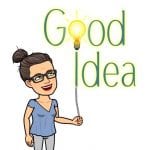 of stakeholders, creating a shared vision and core beliefs, then 2. training, communicating with or informing all stakeholders, followed by 3. implementing the DLE plan of lessons and concepts of digital citizenship and digital literacy, completing the circle by 4. evaluating and reviewing the DLE regularly.
of stakeholders, creating a shared vision and core beliefs, then 2. training, communicating with or informing all stakeholders, followed by 3. implementing the DLE plan of lessons and concepts of digital citizenship and digital literacy, completing the circle by 4. evaluating and reviewing the DLE regularly.
How do we manage the DLE to foster globally connected learning?
As recommended by Lindsay (2016), we need to:
- Discuss the digital footprints or ‘branding’ of all students and make sure they are using long-term appropriate and culturally sensitive language and images.
- Consider the digital divide and make sure that platforms, discussion tools and global or local connections are provided synchronously (in real time) and asynchronously (offline or pre-recorded).
- Create a DLE that offers students opportunities to authentically and collaboratively engage with peers globally. (Lindsay, 2016).
How can we manage the DLE to move students from social media citizens to social media leaders?
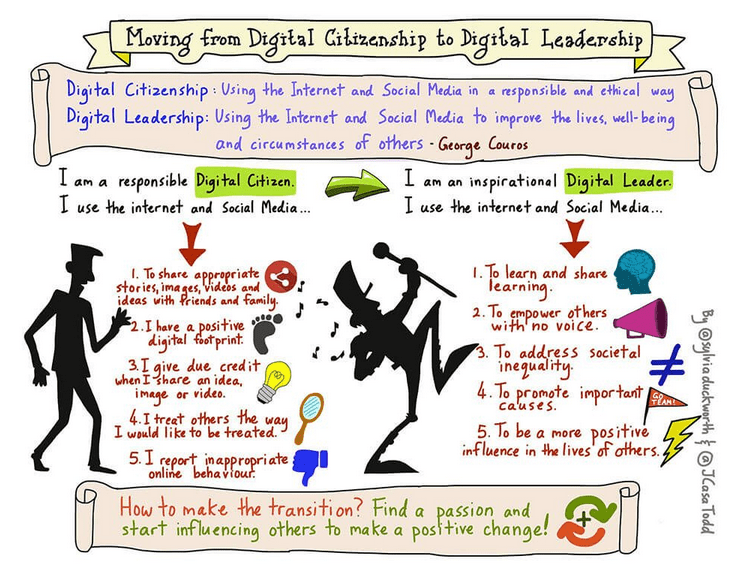
References
Casa-Todd, J. (2016). Rethinking Student (Digital) Leadership and Digital Citizenship [Image]. Retrieved from: https://jcasatodd.com/rethinking-student-digital-leadership-and-digital-citizenship/
Lindsay. J. (2016, July 19). How to encourage and model global citizenship in the classroom. Education Week. Retrieved from http://blogs.edweek.org/edweek/global_learning/2016/07/how_to_encourage_and_model_global_citizenship_in_the_classroom.html
Chen, E., Orth, D. (2013). The strategy for digital citizenship. NAIS Independent School Magazine (online) http://www.nais.org/Magazines-Newsletters/ISMagazine/Pages/The-Strategy-for-Digital-Citizenship.aspx.
14 DLE Digital Citizenship ‘Issues’ (ETL523 Module 2)
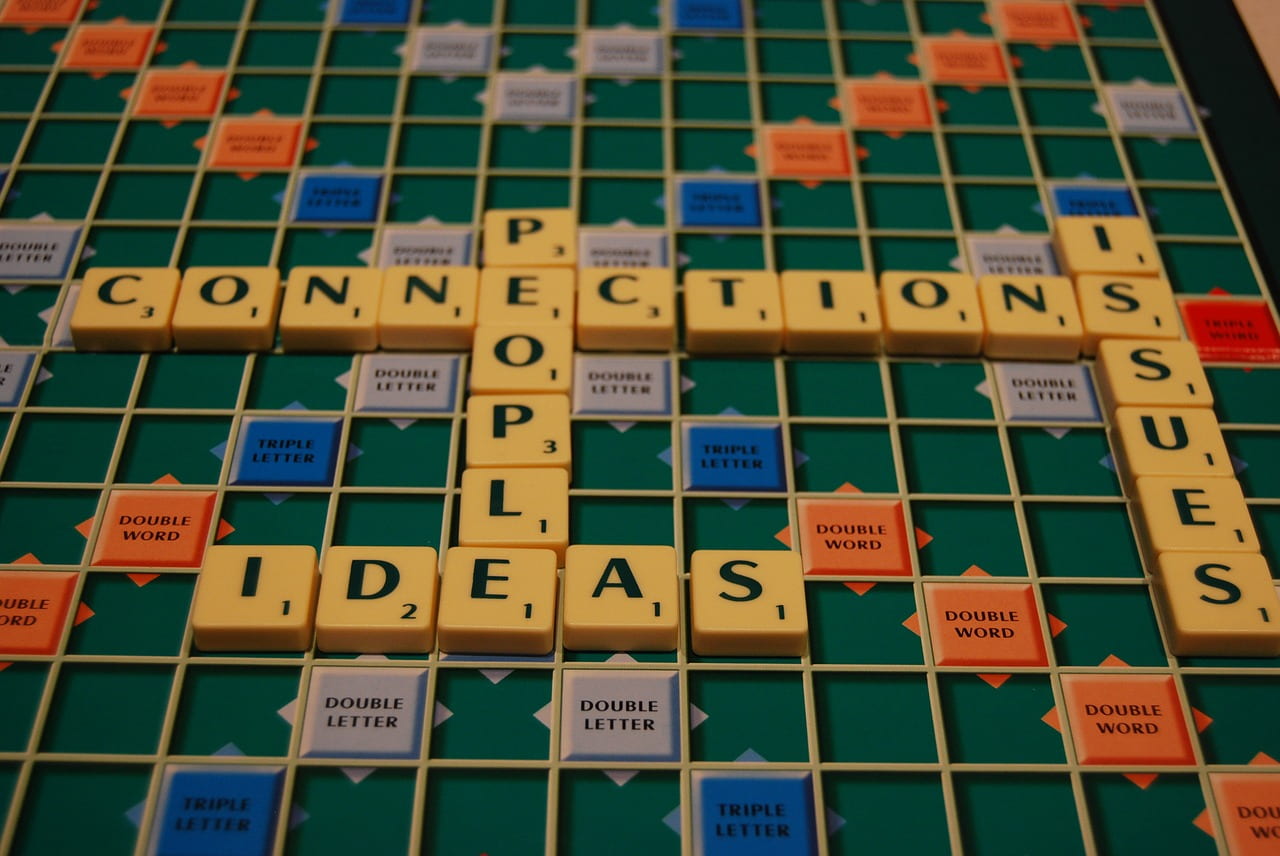
Digital Learning Environments (DLE) and digital citizenship implementation have a few issues and dilemmas that must be considered by teacher librarians, and all educational stakeholders:
- Lack of growth mindset: Educators are often reluctant to change. We expect students to have an open mind to proactively embrace new things and attempt to connect to personal learning networks – and recognise that, generally, failure is a part of learning. We expect 21st century learners to be quick to learn and be resilient, yet we ourselves are sometimes close minded, reactive, afraid to fail, and stuck in ruts and ‘old’ methods or tools – as teacher librarians, we must lead in professional reflection, respond to needs and initiate change, particularly in terms of individualising learning plans and environments and recognising that the ways students access information is much different than what it once was (Cooke, 2012).
- Communication via DLE is different: We must tailor the methods and means by which we communicate to ensure that we are understood and authentic. Communication in an DLE is different to face to face communication in terms of turn taking, online digital footprints or identities may not be authentic, the level of commitment or willingness to behave ethically vary understanding and clarity can be varied or blurred, and community expectations are different (Cooke, 2012).
- Lack of thought into quality control: While there are several methods for measuring teacher quality in recent times, there is no official one way to measure the quality of DLE Digital citizenship lessons or teacher / teacher librarian quality (Cooke, 2012). (NOTE: In fact, 21st century learning skills are themselves very difficult to assess and measure in students. We need to find or design one agreed way of measuring quality teaching!)
- Varied degrees of self-regulation, motivation, & overwhelmed, or distracted students: DLE education is often asynchronous or self directed (Cooke, 2012) relying on a student’s ability to self-regulate and motivate. This is sometimes problematic, not only because of individual student ability levels but also because the DLE can be overwhelming, or a place of distraction or ambiguity (see #14).
- Lack of a fluid community of practice or PLNs: Wenger (p.2, 1998, in Cooke 2012) specifies 3 dimensions of a community of practice: 1. they are joint enterprises, created and maintained by their members, 2. they feature mutual engagement with all members joining to form a social entity, and 3. members have a shared store of resources and sensibilities that have been communally developed. However, Wenger (p.6, 1998, in Cooke 2012) does caution that communities of practice should take care not to become insular, rather they should attempt to remain ‘dynamic and fluid.’ (NOTE: I have discussed the concept of a community of practice at length in other blog posts: 1 or 2– see tags also).
- Content at the cost of engagement and application: Stagnant, repetitive, standardised education, subjects and content are still taught in isolation from each other. Memorising facts and clerical tasks are still, despite being the 21st century, generally considered more important than engaging lessons that link to or apply to real life situations – students should be learning by doing rather than by being told (Wheeler, 2015). (NOTE: Would you rather be treated by a ‘doctor’ who learned medicine by reading about it or would you rather be treated by a doctor who has actual experience treating patients?)
- Critical thought is not taught or supported: Inquiry learning and learning through questioning is still not the preferred method of teaching, ill-preparing students for their ‘why’ and ‘how to’ (rather than ‘what’) futures (Wheeler, 2015). “Critical thinking, flexibility, working collaboratively, and creative problem solving are all key components for success in changing environments. But ‘knowing that’ and ‘knowing how’ will not be enough. Students also need to know why” (Wheeler, 2015, Ch.6, p.9).
- Educators have all the say: According to Wheeler (2015), instead of taking a ‘flipped classroom’ approach where learning is student led, the majority of educators are still deciding the curriculum and delivery of the content, delivering lessons with one way dialogue and lack of conversation. This means that students can become disengaged, disconnected and disempowered from their own learning (Wheeler, 2015). It is crucial that we design engaging lessons and topics and use varied learning approaches in order to promote the ability in students to generate their own ideas and voices (rather than copying the voices of others) (Williamson & McGregor 2011). (NOTE: How many of us consider ourselves facilitators of student learning? I myself have it in my teaching and learning philosophy…Time to put this into action!)
- Lack of digital literacy: as per my previous blog post on Information Literacy and Inquiry Based Teaching: ‘According to the ALA, (2016) we must help our students become information literate individuals who can: “determine the extent of information needed; access the needed information effectively and efficiently; evaluate information and its sources critically; incorporate selected information into one’s knowledge base; use information effectively to accomplish a specific purpose; and understand the economic, legal, and social issues surrounding the use of information, and access and use information ethically and legally” (ALA 2016). This is expanded into Digital Literacy by Stripling (2010) who writes: “Digital literacy, itself, is not enough preparation, however, for our students to thrive in today’s global, information-driven world. Students must also acquire the skills of digital inquiry: connecting ideas to personal interests and a desire to know, asking questions that probe beyond simple fact gathering, investigating answers from multiple perspectives, constructing new understandings, expressing the new ideas through a variety of formats, and reflecting on both the process and product of learning” (p16).
- Constantly evolving trans-literacy (multi-literate) expectations: educators must be able to prepare students to evaluate, access and effectively, ethically and legally utilise a variety of resources and tools across a variety of platforms (Preble, 2013; Wheeler, 2015, p.175).
- The digital divide (as discussed in my previous blog post): the digital divide is closely related to Socio-Economic Status and is not just a lack of access to technological devices or internet, but it is also a lack of the ability to utilise technology, inability to produce content, and/or the lack of the ability to apply digital information and skills to real life applications (Jenkins, Clinton, Purushotma, Robison & Weigel, 2006; & Schradie, 2013). (NOTE: this is something imperative for educators to be reflecting upon NOW during this COVID-19 crisis: the digital divide is real and it has an impact on our students whether they are in lockdown or not! Schools MUST CREATE A PLAN for access to and for digital literacy for all students).
- Confusion, panic and lack of policy regarding intellectual property, copyright, fair use and Creative Commons: Educators must create a policy for intellectual property, copyright, fair use and Creative Commons. Thus, we must create guidelines at whole-school level that promote intellectual honesty and respect for the work of others as an ingrained community value (Williamson & McGregor 2011, p17). Educators must then model and teach deeper digital citizenship knowledge and understanding of what can be used, re-used, and shared in items produced electronically, based on an age appropriate teaching sequence (such as teaching students how to locate key words and write bulleted notes before paraphrasing quotes, as suggested by Williamson & McGregor, 2011).
- Safety in the DLE: The DLE requires educators to help students be aware of safety issues such as cyberbullying, creating a work/life balance, age-inappropriate online communications (eg adult images, videos, ads or ‘chats’). (NOTE: The Australian Government have an e-safety page that is particularly relevant and offers resources to educators). However, we must also teach students how to use social media platforms responsibly (Elkin, 2013; Murray, 2013).
- Lack of content curation, aka overwhelmed due to ‘filter failure’ or narrowed view due to ‘filter bubbles’: We must consider how we curate information within our personal learning networks (see #5), and model and teach students how to evaluate the methods for curation so that they aren’t either overwhelmed due to filter failure or creating a narrow world view due to over-stringent filters that act as ‘filter bubbles.’ (Crowdspoke. (2011, June 7).“good curation tools are those that allow you to: Aggregate and gather web pages specific to the topic; Filter content allows the curator to select the best material; Publish to your collection with ease; Share, syndicate and distribute to your audience and the wider community; Allow the curator to edit and add comments as well as providing a comment stream for the audience to nurture discussion around the article; Analytics so you can track the usage of the site; An export facility or a way to back up the curated work” (Adapted from De Rossi, L.C. and Good, R. 2010).
-
11 further ideas on what to think about from lecturer, Julie Lindsay (in ETL523):
- Have we clearly identified our context (eg k-12 NSW Public School in x suburb…)?
- Do we have a shared vision?
- How can we create personalised learning spaces linked to learning needs?
- Have we considered: Hardware / software / networking access?
- Have we considered: Understanding / experience access?
- Do we know our students’ and teachers’ individual digital profiles?
- Are the tools in our ‘digital tool kit’ age appropriate?
- What evidence are we using to determine best practice for online, topical, or connected learning?
- Do all stakeholders have shared understandings, policies or guidelines?
- Is there a PD program or plan to continually evaluate and support the changing environment (eg. do teachers model the digital citizenship behaviours they expect or teach)?
- How will this be shared and networked within a global professional network(s) and local context(s)?
References:
ALA (2016). Information Literacy Competency Standards for Higher education. Retrieved from: https://alair.ala.org/handle/11213/7668
Cooke, N. A. (2012). Professional development 2.0 for librarians: developing an online personal learning network (PLN). Library Hi Tech News, 29(3), 1-9.
Crowdspoke. (2011, June 7). Understand collective curation in under 90 seconds. http://youtu.be/eW775HIlVMg.
Elkin, Susan. (2013, January 1). It’s vital we teach social networking skills in school. http://www.independent.co.uk/voices/comment/its-vital-we-teach-social-networking-skills-in-school-8434531.html
Jenkins, H., Clinton, K., Purushotma, R., Robison, A. J., & Weigel, M. (2006). Confronting the challenges of participatory culture: Media education for the 21 st century. MacArthur Foundation Publication.
Murray, T. (2013, January 7). 10 steps technology directors can take to stay relevant. http://smartblogs.com/education/2013/01/07/the-obsolete-technology-director-murray-thomas/.
Preble, L. (2013, September 14). Nancy Pearl explains transliteracy. http://youtu.be/pNBlzCMq994.
Schradie, J. (2013, April 26). 7 myths of the digital divide. http://thesocietypages.org/cyborgology/2013/04/26/7-myths-of-the-digital-divide/.
Stripling, B. (2010). Teaching students to think in the digital environment: Digital literacy and digital inquiry. School Library Monthly, 26(8), 16-19.
Wheeler, S. (2015). Learning with ‘e’s: Educational theory and practice in the digital age. Crown House Pub Ltd. (Chapter 6: A 21st Century Curriculum). Retrieved from ProQuest
Williamson, K., & McGregor, J. (2011). Generating knowledge and avoiding plagiarism: Smart information use by high school students. School Library Media Research, 14.
Reflection on Case Study 4 & 5; Roles in Groups and Teams

The Creation of our Group
The creation of our group may have been, according to Belbin (2010) doomed from the start due to the way the group members were selected (which was, presumably and due to the constraints of our online study, fairly random). The creation of a balanced team is very challenging (as detailed in my previous post) and some of the problems that we are showing (mere cracks really, not necessarily conflicts) are indicative of the challenges of creating that balance.
Roles and Participation:
I think our group at this stage of the process are struggling to identify our roles. The person who previously accepted or chose the role of submitting the final ‘Case Study 3’ group post, was displaying a need to maintain that role in the ‘Case Study 4’ post (although she had put her hand up at the start to say that she would not be able to participate as much in case study 4 due to her workload constraints and I was the person in charge of the final submission this week). Perhaps her need to exert herself was a result of her feeling like she had something to prove e.g perhaps she was not happy with her level of participation (Roberts, 2012)?
I know I was not 100% happy the previous person in charge of the submission, as she cut several sentences from my work without checking with me. Rather than approach her regarding this, I chose to defer on the side of caution and recognise that, at the end of the day, working together as a team was more important than the integrity of my work being recognised.
Moreover, leading by example, when it was my turn to be responsible for the final submission, I was very careful to only lightly edit the other team member’s work so that it maintained a consistent and positive flow (e.g. changing the word ‘staff’ to ‘team member’ or ‘library team’). When the person in charge of the previous submission questioned this and suggested I edit the text, I explained why I had not ‘micro edited’ the work of other team members as it can become ‘problematic.’ I am not sure if she got the message but I am hopeful that it doesn’t cause further conflict.
Communication:
The lines of communication are also having a negative impact on our group dynamic (Roberts, 2012). Aside from the communication being 100% electronic (and therefore limited in volume, tone and body language) one of the participants bar myself and one other have contributed to the ‘getting to know you’ forum in our group. In a physical / face-to-face setting, everyone would join in on the discussion about themselves less likely to just sit silently and ignore the conversation like they are in online communication.
Furthermore, the communication is challenging as there are so many options. Some are posting their submissions in the wrong case study and feeling like there are too many areas where the submissions could go (the blog, the discussion the wiki or email).
Where to from here?
The creation of my team in the future will need careful consideration from the employment stage right through to the project completion stage.
In terms of communication, I’m not sure how to make it more clear except to say that a better understanding of where we are meant to chat versus submit our individual work could be more narrow? Maybe if everything was done in either the discussion section as a draft and then in the blog as a final and not anywhere else?
I think, in the future, I might need to be more assertive–rather than avoiding the conflict (Plocharczyk, 2013) and when it is my turn to be ‘in charge’ I lead the team in identifying everyone’s roles or at least helping them be more aware of the possible range of roles that we take on in groups at any given time (such as those listed in my previous post from Roberts, 2012; Porteus, n.d.):
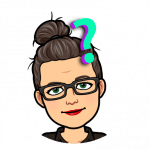 Leadership Thought: Is the case study group work about learning the leadership content better or is it a means in which to learn how to interact in the group as we mean to go forward in our own library or school teams?
Leadership Thought: Is the case study group work about learning the leadership content better or is it a means in which to learn how to interact in the group as we mean to go forward in our own library or school teams?
References:
Belbin, R. M. (2010). The art of building a team. Chapter 9, pp. 97-106. Team roles at work (2nd ed.). Retrieved from ProQuest Ebook Central.
Plocharczyk, L. (2013). Managing conflict and incivility in academic libraries. In K. Blessinger & P. Hrycaj (Eds.), Workplace culture in academic libraries. Retrieved from ProQuest Ebook Central. [Elsevier Science version]
Porteus, A. (n.d.). Roles people play in groups. Stanford University. Retrieved March 5, 2017 from https://web.stanford.edu/group/resed/resed/staffresources/RM/training/grouproles.html
Roberts, R. (2012, September 12). How identifying the different roles can help groups work better together [Blog post]. Retrieved from https://elt-resourceful.com/2012/09/12/how-identifying-the-different-roles-we-play-can-help-groups-work-better-together/
Reflection on ETL504 Module 3.2 (2019): Leading Change
Leading change, solving problems, building teams, effective communication & conflict resolution

Kotter’s 8 steps for leading change (in Madsen, 2016):
- Create urgency – a compelling case for change
- Form a powerful coalition – a team formed with key people as change champions
- Create a vision for change – short, clear, understandable, emotional, relevant and creative
- Communicate the vision – showcase it and demonstrate it
- Remove obstacles – physical or emotional, fears, concerns; use feedback to overcome obstacles
- Create short term wins – phases or steps where each step offers reward
- Build on the change – repeat the steps 1-6 so that it becomes routine
- Anchor the change – embed it into every day practice
“When facing a problematic situation, people can consciously choose to draw on powerful ways of thinking and acting—such as striving for accuracy and drawing on past knowledge. And as a person becomes more disposed to use a particular facet of practical intelligence, that disposition can grow and become more sophisticated” (Claxton, et al., 2016 p. 4).

Soft Skills / Dispositions / & 7 Ways to Problem Solve:
Soft skills or the preferred term: ‘dispositions’ are necessary for today’s workforce: effective communication, collaboration, ability solve problems and fitting in within the school vision. Claxton (et al., 2016)
Removing obstacles & Problem solving is probably the most challenging aspect of soft skills/dispositions (that and fitting in to the school vision – or what is perceived as the school vision). Complex problems cannot be solved easily and have to have a different approach as listed below (BNET Video, 2011; McNamara, 2017; & Belbin, 2010):
- Define the problem / Identifying needs in a statement or group of statements from stakeholders: What, where, how, with whom, when and why is a problem happening and what is the most urgent aspect? (Role titles: shapers and coordinators);
- Collect data about the problem (the what) and its causes (Role titles: Team members);
- Analyse the data for the cause (the why) (Monitors, Evaluators and Specialists);
- Plan a solution or action plan and implement it (the how); Consider what end result we want, plan the steps for success (use SMART steps), identify resources required including time and participants; and determine the roles of each stakeholder for the process; (Role titles: Plants and Resource investigators);
- Evaluate the success or failure based on more data; How will we know we have achieved our goal and solved the problem?; (Role titles: Monitors, Evaluators and Specialists)
- Standardise a solution – make it work in other areas; (Role titles: Implementors and Coordinators); and
- Learn something from this process as a team- what did we do well / poorly / where to next? (Role titles: Motivators; Team workers; Resource investigators; Completer finishers & Implementors).
This problem solving process is also applicable to our teaching practice as pointed out by Claxton (et. al., 2016, p.4), in that we can encourage soft skills / dispositions in our students by having them solve problems by asking themselves questions like:
“How can I draw on my past successes with such problems? What do I already know about the problem, and what resources do I have or might I generate? How might I approach this problem flexibly, looking at the situation in a fresh way? How can I draw upon my repertoire of problem-solving strategies? To make this challenge clearer, can I break this problem into its component parts and develop a strategy for understanding and accomplishing each step? Are there data I can draw on? How do my beliefs, values, and goals interact with this problem? Are any attitudes or emotions blocking—or enhancing—my progress?”

What is a team?
 While reading Belbin (2010) I am struck by the realisation of what was motivating my previous employer to choose me as the teacher who needed to be the one to not have their contract renewed: he didn’t believe I conformed or ‘fit’ into his vision of the school or the culture he and his executive team were building…and maybe there were times that I was taking a counter-productive role…?
While reading Belbin (2010) I am struck by the realisation of what was motivating my previous employer to choose me as the teacher who needed to be the one to not have their contract renewed: he didn’t believe I conformed or ‘fit’ into his vision of the school or the culture he and his executive team were building…and maybe there were times that I was taking a counter-productive role…?
It is interesting to me that Belbin (2010) suggests that the word ‘team’ is often maligned as to mean a ‘group’, ‘flock,’ ‘squad,’ or ‘audience’ rather than what it should be: reciprocated and dynamic engagement between unique and varied individuals.
Effective companies create a balanced or hybrid culture &/or a hybrid team, capable of protecting the company from problems that arise and the destructive work culture cycle [As a ‘team’ arises (however it may come about), a ‘visionary’ work culture is created and the need to be connected to the culture results in conformity. Conformity then results in an inability to speak up and solve problems, which, in turn, results in a leaders becoming ‘hard nosed’ towards members of the team in order to motivate and engage them. A group of leaders become ‘the shapers’ and a group of followers become ‘the team’ (Belbin, 2010)].
Creating a balanced team in 8 steps:
- Creating a balanced team begins with the vision of employment based on a need for a diverse range of team members, rather than someone who ‘fits’ with those already employed – a focus on skills rather than personality or conformity (Belbin, 2010);
- Goals of the company need to be clear as this will effect the creation of individual job roles (Belbin, 2010);
- Roles need to be well communicated so that all stakeholders are knowledgable about the abilities within the team (Belbin, 2010);
- Roles need to be flexible, so that as the team grows or changes, so too can the roles and voids can be filled or accommodated (Belbin, 2010);
- There are many kinds of roles that people can have, but according to Porteus, (n.d).; and Roberts, (2012), they all have one of three themes: Roles for tasks: Initiator- contributor: suggests new ideas; Information seeker: clarifies details; Opinion seeker or consensus tester: looks for opinions or values of others; Elaborator or clarifier: provides examples; and Orienter: summarises and keeps everyone focused. Maintenance roles (working smoothly): Encourager: Offers acceptance or praise; Harmoniser: mediator in conflicts; Expresser: senses group feelings and seeks clarification; Gatekeeper: keeps communication flowing; Compromiser: one who attempts conflict resolution; and Standard setter: testing overall group satisfaction with the process. Counterproductive roles: Aggressor: putting others down; Blocker / Un-cooperator: negative, stubborn and difficult; Withdrawer: removed from interactions either physically or mentally; Side-conversationalist: whispering, giggling, or having private conversations that distract or exclude others; Degrader: puts people down either directly or through jokes; or Dominator: is controlling or monopolises the group;
- Start with a talented person in the required area and find a manager who can relate well to that person, defending, guiding, supporting or mentoring them (Belbin, 2010);
- Keep team numbers small wherever possible (Belbin, 2010);
- The team must form an agreement on their operational style (Belbin, 2010).
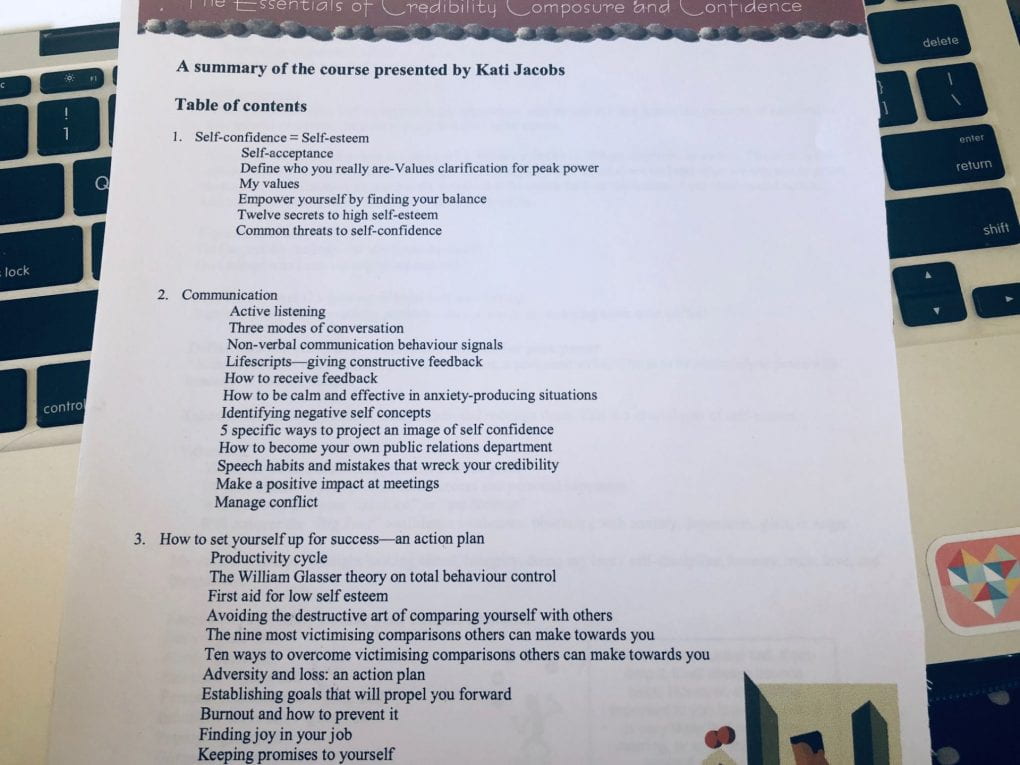
14 Rules for Effective Communication:
 I worked in a call centre in the finance sector for many years in my 20’s just after I immigrated to Australia. Luckily, my employer was a large, publicly listed company who invested heavily in employee training and as a result, I have an in-depth understanding of communication — I just need to remember it all! Much of what was said in the videos in Module 3.2 (2019) Leading Change was a refresher for me.
I worked in a call centre in the finance sector for many years in my 20’s just after I immigrated to Australia. Luckily, my employer was a large, publicly listed company who invested heavily in employee training and as a result, I have an in-depth understanding of communication — I just need to remember it all! Much of what was said in the videos in Module 3.2 (2019) Leading Change was a refresher for me.
In the communication video (Alanis Business Academy, 2012) and in the Ceconi video (Nohria, 2016), Davies (n.d.), Minute MBA (2012) and in the Bender (2005) book chapter, I think it was important to note:
- Even when we don’t communicate, we are always communicating, either directly or indirectly – [which links to the ‘NSW DET Positive Behaviour for Learning’ and other child services mantra that ‘all behaviour is communication’];
- We need to recognise and follow the school’s hierarchy (seeking clarification and improving policies in times of doubt);
- We need to keep communication open even in challenging situations, utilising a variety of communication formats and refrain from being distracted;
- We need to remember to begin and end with positives and emphasise areas in which we agree (particularly, in Australian settings, performing an Acknowledgement of Country and brief welcome to individuals at the start of every meeting);
- We must consider the communication device carefully, taking into account ease of communication, our (direct) words (30% of communication) as well as the other (indirect) 70% of communication: body language, tone and volume (or lack thereof in digital formats);
- We need to consider our own encoding barriers and the barriers of our receiver: environment preferences, knowledge, age, personality, habits, background, social customs, emotional and mental diversity;
- Because of the barriers listed in #6, we also need to make a real effort to be careful and thoughtful of what we say and how we say it, e.g. adjusting language to suit the situation; using jargon, technical terms versus informal language; and trying to use ‘I’ statements wherever possible as opposed to ‘you’ statements;
- We need to be respectful, (rather than the most recently maligned ‘political correctness’) in both formal and informal situations;
- We need to be clear, concise and consistent when communicating across all platforms, regardless of whether your communication is about positive or negative information;
- We need to keep and open mind and be willing to compromise – and not just expect compromise from the receiver;
- The receiver decodes the message amongst ‘noise’ in the background, physical, mental or emotional issues that must also be considered; We need to monitor the receiver for active listening;
- Request or expect regular and ongoing feedback from the receiver (eg. ‘what I heard you say was…’) which we should not be jumping to conclusions, getting distracted nor thinking of our own response but instead, we must actively listen to the receiver’s message and remember what they have said; and
- We should respect the receiver’s confidentiality and avoid gossip [‘triangles.]
- We need to follow up and action anything that comes up in our conversations and survey our team to see if we are being productive leaders, such as a 360 Degree Feedback Survey (or similar).

Conflict Resolution:
Conflict (or ‘dissensus’) can be a great avenue for ‘win/wins’ and authentic change in an organisation (Plocharczyk, 2013, p.308). Our job as leaders in times of conflict is: timely, transparent and open communication, listening (actively), responding with new points of view and perspectives, and resolution by encouraging creative innovations – never avoidance (Plocharczyk, 2013, p.311). We need to focus on the process/’the how’ the work is being done, rather than the people/’the who’ doing the work (Johnson in Plocharczyk, 2013 p.316). We need to have proactive, clear guidelines and policies for behaviour defined and communicated simultaneously, so that everyone understands the policy and the restorative practices that will occur in the event of inappropriate behaviours.
Types of conflict (more than one can occur at a time): Intra-personal (conflict within yourself); Solution: releasing anxiety through talking to others; Interpersonal (individual conflict with another person); Solution: adjustments or mediation; Intra-group (individual conflict within members of a team); Solution: embracing the conflict as necessary part of problem-solving (see this article by Jacob Stringer on New Compass about consensus versus dissensus) and goal achievement or mediation; Intergroup (a group conflict with another group in the organisation); Solution: clarification of goals, interests, competition, resources, or group identity (Evans, 2013); and Task / Organisational (individual conflict with others based on the constructs or policies of an organisation such as tight budgets, shared resources, unequal workloads, unclear future employment, boredom or undefined values, goals, objectives or role descriptions); Solution: ‘integrative conflict management’, collaboration, analytical thinking, problem solving, mediation from a third party, or clarification/revision of company policies (Plocharczyk, 2013, p.311).
So what kind of conflict manager will I be? I took the survey suggested in the module but I didn’t really get much out of it. The questions seemed repetitive and out of context. I often get emotional at conflict situations, depending on who they are with. (I have  anxiety, undiagnosed, in all social situations but particularly those that are new or unfamiliar). I recognise that and try to listen more than I speak.
anxiety, undiagnosed, in all social situations but particularly those that are new or unfamiliar). I recognise that and try to listen more than I speak.
I like the idea of having a policy on behaviour (like the NSW DET Code of Conduct) and utilising the Positive Behaviour for Learning / Restorative practice techniques that we use with students also in my work team. I realise there are those who disagree that behaviour is communication but I do believe that it is. And it is my job to listen to that behaviour and act appropriately. I will try to use Judy Ringer’s checklist in times of conflict, and a 360 Degree Feedback Survey (or similar) to make sure I am communicating and responding appropriately… Hope I will be up to the challenge!
References:
Alanis Business Academy. (2012, August 2). Episode 19: How the communication process works [Video file]. Retrieved from https://www.youtube.com/watch?v=q6u0AVn-NUM
[7.35 mins]
Belbin, R. M. (2010). The art of building a team. Chapter 9, pp. 97-106. Team roles at work (2nd ed.). Retrieved from ProQuest Ebook Central.
Bender, Y. (2005). Building effective communication, Part 1, p.3-18. The tactful teacher: Effective communication with parents, colleagues and administrators. Chicago, IL: Nomad Press. Retrieved from ProQuest Ebook Central.
BNET Video. (2011, June 8). 7 step problem solving. [Video file]. Retrieved from https://www.youtube.com/watch?v=bZXDGQSuF9I [4.38 mins]
Claxton, G., Costa, A., & Kallick, B. (2016). Hard thinking about soft skills. Educational leadership. 73-6 p.60-64. Retrieved from https://www.learningpersonalized.com/wp-content/uploads/2016/09/Hard-Thinking-about-Soft-Skills.pdf
Davies, L. (n.d.). Effective Communication. In Kelly Bear. Retrieved from http://www.kellybear.com/TeacherArticles/TeacherTip15.html
Evans, B. (2013, August 16). Types of conflict: Four classifications [Blog post]. Retrieved from http://www.typesofconflict.org/types-of-conflict/
Madsen, S. (2016). Kotter’s 8 step change management model [Video file]. Retrieved Mar. 2017 from https://www.youtube.com/watch?v=7qlJ_Y8w5Yk [4 mins]
McNamara, C. (2017). Problem solving and decision-making. In Free Management Library, Retrieved from http://managementhelp.org/personalproductivity/problem-solving.htm#guide
Minute MBA. (2012, November 13). Let your ears do the talking: How good managers listen [Video file]. OnlineMBA.com. Retrieved from https://www.youtube.com/watch?v=nk1VnXTC1_I [1.39 mins]
Nohria, N. [HR360Inc]. (2016, January 7). Steps to successful employee communication [Video file]. Retrieved from https://youtu.be/bRXLTZMvy-U
Plocharczyk, L. (2013). Managing conflict and incivility in academic libraries (part 12). In K. Blessinger & P. Hrycaj (Eds.), Workplace culture in academic libraries. Retrieved from ProQuest Ebook Central. [Elsevier Science version]
Porteus, A. (n.d.). Roles people play in groups. Stanford University. Retrieved March 5, 2017 from https://web.stanford.edu/group/resed/resed/staffresources/RM/training/grouproles.html
Roberts, R. (2012, September 12). How identifying the different roles can help groups work better together [Blog post]. Retrieved from https://elt-resourceful.com/2012/09/12/how-identifying-the-different-roles-we-play-can-help-groups-work-better-together/
